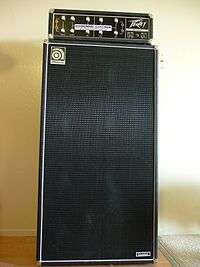Bass amplifier
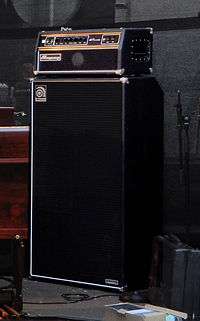
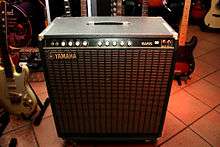
.jpg)
A bass amplifier or "bass amp" is a musical instrument electronic device that uses electrical power to make lower-pitched instruments such as the bass guitar or double bass loud enough to be heard by the performers and audience. Bass amps typically consist of a preamplifier, tone controls, a power amplifier and one or more loudspeakers ("drivers") in a cabinet. While bass amps share many features with the guitar amplifiers used for electric guitar, such as providing an amplifier with tone and volume controls and a carrying handle, they are distinct from other types of amplification systems, due to the particular challenges associated with low-frequency sound reproduction. This distinction affects the design of the loudspeakers, the size and design of the speaker cabinet and the design of the preamplifier and amplifier. Speaker cabinets for bass amps usually incorporate larger loudspeakers (e.g., 15" speakers are more common for bass than for electric guitar amps) or more speakers and larger cabinet sizes than those used for the amplification of other instruments. The loudspeakers themselves must also be sturdier to handle the higher power levels and they must be capable of reproducing very low pitches at high sound pressure levels.
Bass amp speaker cabinets are typically more rigidly constructed, with thicker wood and more heavy bracing than those for non-bass amplification. They usually include tuned bass reflex ports or vents cut into the cabinet, for increased efficiency at low frequencies and improved bass sound. Preamplifier sections have equalization controls that are designed for the deeper frequency range of bass instruments, which extend down to 41 Hz or below. Bass amplifiers are more likely to be designed with heat sinks and/or cooling fans than regular guitar amplifiers, due to the high power demands of bass amplification. They are also more commonly equipped with audio compression or limiter circuitry to prevent overloading the power amplifier and to protect the speakers from damage due to unintended clipping in the power amp.
A common format of bass amplifier–the "combo" amp–contains the amplifier electronics and one or more speakers in a single wooden cabinet. Combo amps have been used by musicians since the 1920s, as they are convenient for transporting to rehearsals and for performances at small to mid-size venues. Combo amps range from small, low-powered "practice amps" used for individual practice, to mid- and large-size and more powerful combo amps which produce enough volume for rehearsals and small to mid-size venues (e.g., nightclubs). For larger venues, such as stadiums, bassists may use the "bass stack" approach, in which one or more separate speaker cabinets, each with one or more speakers (but not containing an amplifier) and a separate "head" containing the amplifier electronics are used. With a large "bass stack", a bassist can obtain a much higher wattage and onstage volume than a "combo" amp could provide. As with an electric guitar amp, a bass amp is not simply used to make the instrument louder; performers use the preamplifier and equalizer controls and, particularly in amps from the 1980s and 1990s onward, the onboard electronic effects, to create their preferred tone.
In the 2000s, new developments in bass amplifier technology include the use of lightweight neodymium magnets in some higher-priced cabinets and the use of lightweight, powerful Class D amplifiers in some combo amps and amp heads; both of these innovations have made transporting amps and cabinets easier. As well, some 2010s-era bass amps and heads have digital effects units and modelling amplifier features which enable the recreation or simulation of the sound of numerous well-known bass amps, including vintage tube amplifiers by famous brands (e.g., Ampeg SVT-Pro amp heads) and a range of speaker cabinets (e.g., 8x10" cabs). Digital amp and cabinet modelling also makes transporting bass amps and cabinets to gigs and recording sessions easier, because a bassist can emulate the sound of many different brands of very large, heavy vintage gear without having to bring the actual amps and cabs. Another trend for higher-priced and higher-wattage amps and cabinets aimed at professionals is providing Speakon speaker jacks in addition to, or in place of traditional 1/4" speaker jacks. Speakon jacks are considered safer for high wattage amps, since the bassist cannot accidentally touch the "live" parts of the cable end and they lock in, so there is less risk of accidental disconnection. As of 2017, a few digital amp and cabinet modelling amplifiers have a USB input or other computer input, to enable users to download new sounds and presets.
History
1920s–1940s
%2C_Amplifier_(mid_1930s)%2C_Console_piano%2C_Museum_of_Making_Music.jpg)
The electric bass was invented in the 1930s, but the instrument did not sell well until Leo Fender developed the Precision Bass in the 1950s. As such, the type of bass players who first began trying methods to make their instruments louder with amplifiers and speakers were upright bass players. While the upright bass is a large instrument, standing about six feet tall (with its endpin extended), due to its low register, it is not a loud instrument when played acoustically. This is largely a result of the decreased sensitivity of human hearing, which is most sensitive to mid-range tones; equal perceived loudness for a mid-range sound and a low frequency sound requires much more acoustic power in the low-frequency sound. In the 1890s and early 1900s, upright bass players performing in bars and brothels in an era before amplifiers and speakers were available, particularly those who performed in bands with louder instruments such as trumpet, often found it hard to be heard. About the only solution available in the pre-amplifiers era was playing slap bass, a style of slapping the strings against the fingerboard to make a relatively loud percussive sound. Beginning in the 1920s, the first amplifiers and speakers designed for gigging musicians became available.
From the 1920s to the 1940s, upright bass players who wanted to strengthen the acoustic sound of their instrument had to use small portable PA systems or guitar amp combos designed for acoustic guitar or archtop guitars. Since these systems were not specifically designed to amplify bass instruments, it is unlikely they provided good low-frequency sound reproduction (particularly guitar amps, which are not designed to go down as low in pitch as the low E (41 Hz) and A (55 Hz) strings). In the early 1920s, it was very hard for an upright bass player (indeed for any musician) to find any amplifier and speaker system to make their instrument louder. The only speakers that could be bought during the early 1920s were "radio horns of limited frequency range and low acoustic output", and the cone speaker (which is widely used in modern-era amp cabinets), was not offered for sale until 1925. The first amplifiers and speakers were PA speaker setups; while an upright bassist could potentially have used one of these early PA systems, they could only be powered with large batteries, which made them heavy and hard to carry around. When engineers developed the first AC mains-powered amplifiers, they were soon used to make musical instruments louder.
Engineers invented the first loud, powerful amplifier and speaker systems for public address systems and movie theaters. These large PA systems and movie theatre sound systems were very large and very expensive, and so they could not be used by most touring and gigging musicians. After 1927, smaller, portable AC mains-powered PA systems that could be plugged into a regular wall socket "quickly became popular with musicians"; indeed, "...Leon McAuliffe (with Bob Wills) still used a carbon mic and a portable PA as late as 1935." During the late 1920s to mid-1930s, small portable PA systems and guitar combo amplifiers were fairly similar. These early amps had a "single volume control and one or two input jacks, field coil speakers" and thin wooden cabinets; remarkably, these early amps did not have tone controls or even an on-off switch.[1] While we do know that these late 1920s portable PA systems were used by guitarists and singers, it is not known whether upright bass players used these PA systems.
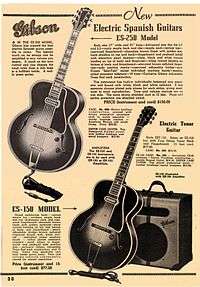
In 1928, the Stromberg-Voisinet firm was the first company to sell an electric stringed instrument and amplifier package. However, musicians found that the amps had an "unsatisfactory tone and volume, [and] dependability problems", so the product did not sell well. Even though the Stromberg-Voisinet amp did not sell well, it still launched a new idea: a portable electric instrument amp with a speaker, all in an easily transported wooden cabinet. In 1929, Vega Electrics launched a portable banjo amplifier. In 1932, Electro String Instruments and amplifier (this is not the same company as Stromberg Electro Instruments) introduced a guitar amp with "high output" and a "string driven magnetic pickup". Electro set out the standard template for combo amps: a wooden cabinet with the electronic amplifier mounted inside, and a convenient carrying handle to facilitate transporting the cabinet to rehearsals and shows. 1n 1933, Vivi-Tone amp set-ups were used for live performances and radio shows. In 1934, Rickenbacker launched a similar combo amp which added the feature of metal corner protectors, which keep the corners in good condition during transportation.[1]
In 1933, Dobro released an electric guitar and amp package. The combo amp had "two 8″ Lansing speakers and a five-tube chassis. Dobro made a two speaker combo amp that was on the market over 12 years before Fender launched its two-speaker "Dual Professional/Super" combo amp. In 1933, Audio-Vox was founded by Paul Tutmarc, the inventor of the first electric bass (Tutmarc's instrument did not achieve market success until Leo Fender's launched the Precision Bass). In 1933, Vega sold a "pickup and amplifier set" which a musician could use with her/his existing guitar. In that same year, the Los Angeles-based Volu-Tone company also sold a pickup/amplifier set. Volu-Tone used "high voltage current" to sense the string vibration, a potentially dangerous approach that did not become popular. In 1934 Dobro released a guitar amp with a vacuum tube rectifier and two power tubes. By 1935, Dobro and National began selling combo amps for Hawaiian guitar. In 1934, Gibson developed prototype combo amps, but these never got produced and sold. By 1935, Electro/Rickenbacher sold "more amps and electric guitars than all the amps and electrified/electric guitars made from ’[19]28 through the end of ’[19]34, combined".[1]
The first electric instrument amplifiers were not designed for use with electric guitars. The earliest examples were portable PA systems, which appeared in the early 1930s when the introduction of electrolytic capacitors and rectifier tubes allowed the production of economical built-in power supplies that could be plugged into wall sockets, instead of heavy multiple battery packs, since rechargeable batteries would not become lightweight until many decades later. While guitar amplifiers from the beginning were used to amplify acoustic guitar, electronic amplification of guitar was first widely popularized by the 1930s and 1940s craze for Hawaiian music, which extensively employed the amplified lap steel Hawaiian guitar.[2]
In the 1920s, the earliest combo amplifiers did not have any tone controls. Tone controls on early guitar amplifiers were very simple and provided a great deal of treble boost, but the limited controls, the loudspeakers used, and the low power of the amplifiers (typically 15 watts or less prior to the mid-1950s) gave poor high treble and bass output. This made these early amplifier/speaker systems a poor way for upright bass players to amplify the sound of their instruments.
1950s–1970s
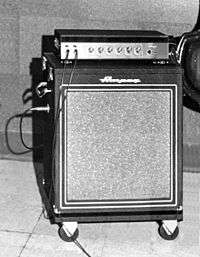
Although the electric bass was invented in the 1930s by Paul Tutmarc, his new instrument did not sell well. It was not until Leo Fender developed the Fender Precision electric bass in 1950 that this new instrument took off in the marketplace. Unlike the upright bass, a solid-body electric bass does not produce acoustic sound from a hollow body; while an upright bass player often benefits from using a bass amp, a bass amp is a necessity for an electric bass player.
The Ampeg Bassamp Company, founded in 1949 by Everett Hull, responded to the growing demand for electric bass equipment by producing a line of bass amplifiers. Ampeg bass amps were widely used by electric bass guitarists in the 1950s and 1960s. The first bass amplifier offered by Ampeg was an 18-watt model with a single 12" speaker and a rear ventilation port called the Super 800. In 1951, they introduced a 20-watt version with a 15-inch speaker. In 1960, they introduced the B-15 Portaflex, a flip-top 25-watt tube bass amplifier with a single 15" speaker. While the Ampeg Portaflex had a pleasing bass tone, and was used by studio bassists such as James Jamerson and Carol Kaye, it was not powerful enough to be used in a stadium or arena concert.[3]
By the late 1960s, as electric guitarists in rock bands began using powerful, loud guitar stacks to play large venues, bassists needed a large, powerful bass stack to keep up in these performance settings.[3] The Acoustic 360 was a "200-watt, solid state head designed to drive the 361 cabinet, a rear-firing 18” speaker enclosure".[3] The engineers who designed the amp and cabinet in 1967, Harvey Gerst and Russ Allee, mounted the 18" speaker in a folded horn enclosure; the 360 amp had a built-in fuzz bass effects unit.[4] The Acoustic 360 and its 361 cabinet "...got the bass world ready for the Woodstocks, Altamonts and giant festival concerts" and it was used by notable players such as funk bassist Larry Graham, Led Zeppelin's bassist John Paul Jones and jazz fusion player Jaco Pastorius.[3] John Paul Jones used two of the amp/cabs in Led Zeppelin; Dave Brown used them with Santana; John McVie played with the amp/cab in the beginning years of Fleetwood Mac.[4] In December 1967, the loud sound of the Acoustic 360 led to The Doors getting "...arrested for noise violations".
Another 1960s-era amp and speaker that was used for loud, large venue performances was the Ampeg SVT (Super Vacuum Tube), a 300-watt amplifier head "powered by fourteen [vacuum] tubes" designed to be used with an 8x10" speaker cabinet.[3]
The Vox T-60/AC-100 bass amplifier uses two 15-inch cabinets and thirty-to-forty watts of solid-state power using "germanium transistors".[5] The Sunn Model T was used by The Moody Blues, Kiss, Queen, The Who's John Entwistle and Rush's Geddy Lee.[5] The Sunn used a 150-watt amp with "four 12AX7WA tubes, followed by two 12AX7A tubes, and powered by four 6L6GC tubes".[6]
The Gallien-Krueger 800RB was a solid state bass amplifier head introduced in 1983 that was liked by bassists for its loud, clean sound and durable construction. It introduced the concept of bi-amplification, as it sent 300 watts of low register sound to the bass speakers and 100 watts to the tweeter.[6] The GK used a tube preamp simulator circuit called "boost". GK 800RB users include Red Hot Chili Peppers bassist Flea and Guns and Roses' Duff McKagan.[6]
The Marshall JMP Super Bass is a 100 watt amp. Lemmy, bassist/lead singer of Motörhead, used numerous of these amps to drive cabinets with four 12" speakers and others with four 15" speakers. His amps were labelled named “Killer,” “No Remorse,” and “Murder One".[5] The Peavey Mark IV is a large, solid-state amp providing 300 watts at 2 ohms; the Mark IV was known for its affordable price and its reliability.[6]
When the Fender company invented the first widely produced electric bass guitar (the Fender Precision Bass) they also developed a bass amplifier, the Fender Bassman, first produced in 1952. This was a 26-watt tube amplifier with a single 15" speaker. In 1954, the Bassman was redesigned to use four 10" speakers. This speaker cabinet was an open-back design; as such, it had poor low-frequency efficiency and was prone to blowing speakers when used for bass because of the lack of damping. Somewhat ironically, it became very popular as an electric guitar amplifier. The circuit design also underwent repeated modifications. The "5F6A" circuit introduced in 1958 is regarded as a classic amplifier design and was copied by many other manufacturers, such as Marshall.
.jpg)
The early rock bands of the 1960s used the PA system only for vocals. The electric guitarist and electric bassist had to produce their sound for the hall, club or other venue with their own amplifiers and speaker cabinets. As a result, bass players from the 1960s often used large, powerful amplifiers and large speaker cabinets. Some bass players would even use multiple bass amplifiers, with the signal from one bass amp being sent to one or more "slave" amps. In the mid-1960s John Entwistle, the bassist for The Who, was one of the first major players to make use of Marshall stacks. At a time when most bands used 50 to 100-watt amplifiers with single cabinets, Entwistle used twin stacks with new experimental prototype 200-watt amplifiers. This, in turn, also had a strong influence on the band's contemporaries at the time, with Jack Bruce of Cream and Noel Redding of the Jimi Hendrix Experience both following suit.
Entwistle also experimented throughout his career with "bi-amplification," where the higher frequencies of the bass sound are divided from the lower frequencies, with each frequency range sent to separate amplifiers and speakers. This allows for more control over the tone, because each portion of the frequency range can then be modified (e.g., in terms of tone, added overdrive, etc.) individually. The Versatone Pan-O-Flex amplifier used a different approach to bi-amplification, with separate amplifier sections for bass and treble but a single 12-inch speaker. The Versatone was used by well-known bassists such as Jack Casady and Carol Kaye.
1980s–2010s
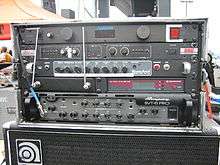
As PA systems improved, horn-loaded "bass bins" and subwoofers were added and were often well-equipped to amplify directly-fed bass guitar and keyboard frequencies. As well, in the 1980s and 1990s, monitor systems were substantially improved, which allowed sound engineers to provide on-stage musicians with a loud, clear, and full-range reproduction of their instruments' sound.

As a result of the improvements to PA systems and monitor systems, bass players in the 2000s no longer need to have huge, powerful bass amplifier systems to play stadiums and arenas. Instead of playing with two 8x10" bass stacks and one or more huge, powerful bass heads, in the 2010s, many bass players perform at large live venues with relatively small and less powerful bass amplifiers. The reason they can do so is that most higher-priced 2010s-era bass amplifiers usually have DI output jacks that can be patched into the audio snake cable, and then plugged into the mainstage mixing board and amplified through the PA system or sound reinforcement system.
In the 2010s, virtually all of the sound reaching the audience in large venues comes from the PA system or sound reinforcement system, the huge speaker systems pointed at the audience. As well, in the 2010s on-stage instrument amplifiers are more likely to be kept at a low volume, because when band members have their onstage amps "cranked" to high volume levels on stage, this makes it harder for the audio engineer to control the sound mix and blend. For example, if a heavy metal bassist had two 8x10" cabinets and several 1x18" subwoofer cabinets and several thousand watts of bass amplifier heads, and these amps are set to a very high volume level, this bass player will be creating very significant onstage bass volume. If the sound engineer wished to turn down the bass in the PA/sound reinforcement system, this bassist's loud onstage volume would make it hard for this engineer to control and/or reduce the volume of bass in the FOH (Front of House) sound mix. Another issue that can develop with bass players who have very high onstage volume is that it can be hard for the audio engineer to produce a clean sound through the PA/sound reinforcement system. For example, if a bassist was driving her bass amp speaker stacks into clipping to create a fuzz bass tone, if the audio engineer wished to have a "clean" bass sound, this could pose a challenge.
As a result of requests by audio engineers to reduce onstage volume, in the 2010s, in many large venues. much of the on-stage sound reaching the musicians now comes from the monitor speakers or in-ear monitors, not from the instrument amplifiers. Stacks of huge speaker cabinets and amplifiers are still used in concerts in some genres of music, especially heavy metal, but they tend to be used more for the visual effect than for sound reproduction.
In some small to mid-size venues, such as bars and nightclubs, the PA system may not have the capacity to provide the bass sound for the venue, and the PA system may be used mainly for vocals. Bass players in bands that play at a variety of venues, including these types of small to mid-size venues, may need to be able to provide the bass sound for the venue, and so they will require a large combo amp or bass stack with this capability.
Types
Different types of equipment are used to amplify the electric bass and other bass instruments, depending on the performance setting, style of music, the sound desired by the bassist, the size of the venue and other factors, such as whether a bassist is an amateur or professional musician. Professional bassists are more likely to have expensive "boutique" amps and cabinets. All types of bass amps and cabinets are designed to be transportable to shows and recording studios, and as such, most have various features to protect the cabinet (e.g., metal or plastic corner protectors) and speakers (a plastic screen or metal grille) during transportation and move the equipment (a single carry handle is standard for practice amps and combo amps and two handles are sometimes provided for two-handed carrying of large cabinets, and wheels are mounted on some large combo amps and cabinets). Amplifier "heads" may be sold mounted in a wooden cabinet with a carrying handle, or they may be sold as rackmount-able components, which can be screw-mounted in a 19" road case for protection. The speaker enclosures for combo amps and speaker cabinets are typically covered in stiff vinyl, carpet, felt or other sturdy fabric, or painted.
Practice amps
The smallest bass amps, which typically have 10 to 20 watts of power and a small 6.5" or 8" speaker, are known as practice amps. They amplify the instrument enough for individual practice in a small room, such as a bedroom. Practice amps do not typically produce enough volume or low-frequency sound reproduction to be used in a band rehearsal or show. As such, they are mostly used by beginners or, when used by professionals, for warm-up or individual practice. They are more likely than full-size combo amp cabinets to have an open-back design, like an electric guitar combo amp. The use of an open back cabinet in small practice amps makes these models different from most bass combo amps and speaker cabs, which are closed-back (often with bass reflex ports or vents, or less commonly, with passive radiator speakers, both of which are designed to boost the low-frequency response). Some buskers playing on the street for tips may use battery-powered practice amps, a feature available on some models.
Practice amps often have an auxiliary line-in jack, so that the bassist can plug in a recorded music signal (often via an 1/8" jack), to practice along with a recording. The line-in jack can also be used to plug a drum machine into the amp, also for practice purposes. Some practice amps have a level control knob for the line-in input. Practice amps often have a headphone jack, with a feature that turns off the power amplifier when headphones are connected. This feature enables bassists to practice silently at night, to avoid disturbing others in adjoining rooms or apartments. Higher-priced practice amps aimed at pro bassists may have a DI out jack, so that the amp's preamplifier signal can be connected directly to a mixing board for a live show's sound reinforcement system or for a sound recording session. DI out-equipped units effectively turn the practice amp into a preamplifier unit.
A device similar in function to a practice amp is a headphone amp. It amplifies the signal from an electric bass so that a bassist can hear the instrument with headphones. Headphone amps can be used for pre-show warm-up or silent practice in a hotel room or apartment where the use of a bass amp and speaker could create a noise disturbance.
Combo amps
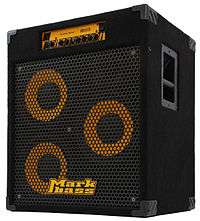
For rehearsals, studio recording sessions, or small club performances, electric and upright bass players typically use a "combo" amplifier, which combines a preamplifier, tone controls, a power amplifier and a speaker (or multiple speakers) in a single cabinet. Combo amps come in a variety of speaker configurations, such as one speaker (e.g., often one 12" speaker or one 15" speaker, although there are some micro-amps with one 10" speaker) or two speakers (e.g., two 10" speakers) or four speakers (e.g., four 10" speakers). The dividing line between practice amps and combo amps that can be used for live venue shows is described in the power in watts section. The most powerful combo amps available deliver between 800 and 1000 watts to the internal speakers.
Smaller combo amps may be easier to transport and set up than using separate amplifier and speaker units, and as such, they are a popular choice for many bass players. Bass players in quieter, more acoustic genres (e.g., jazz quartets which play in a wine bar or a folk music group which plays in a coffeehouse) may be able to use smaller, more modestly powered combo amps. Bassists who play in genres more associated with a high stage volume (e.g., hard rock or electric blues) may tend to use, larger, more powerful (in wattage) combo amps. While a gigging musician will typically only bring one combo amp to a show or recording session, some bassists in major touring bands have two or more combo amps on stage, with an "A/B" switching pedal used to select different amplifiers. In this way, a bassist could have a vintage tube combo amp and a modern solid state amp, and then switch between them to select a different tone for different songs.
Bass stacks
For larger venues such as stadiums and outdoor music festivals, or for music genres that use bass instruments with an extended lower range and high stage volumes (e.g., heavy metal music, grunge, hardcore punk), bass players often use a more powerful amplifier (300 to 2000 watts or more) and one or more separate speaker cabinets (often called "cabs") in various combinations. Using a separate amplifier cabinet and speaker cabinets is colloquially referred to as a "bass stack". An example of the powerful, loud bass amplifier systems used in grunge is Alice in Chains bassist Mike Inez's setup. He uses four Ampeg SVT-2PRO amplifier heads, two of them plugged into four 1x18" subwoofer cabinets for the low register, and the other two plugged into two 8x10" cabinets.[7]
A bass stack may use a single speaker cabinet (e.g., the huge 8x10" cabinets widely used by hard rock and metal bassists). The 8x10" cabinet is often provided as "backline" equipment at music festivals; this way, all the bassists from the different bands can use the same amplifier and speaker cabinet. This reduces the transition time between bands, because the roadies do not have to remove the previous band's bass stack and bring in the subsequent band's stack. Using one 8x10" as backline gear for an entire music festival also makes the transition easier for the audio engineer, because she can have an XLR cable plugged into the amp head's DI unit output (to get the bass amp's signal so that it can be mixed into the sound reinforcement system mix) and have a mic set up in front of the cabinet, to capture the amp and speaker cabinet's distinctive tone. The 8x10" cabinet is widely used by heavy metal music, hardcore punk and psychobilly bassists, as these genres use a loud onstage volume. Some metal bassists, such the bass player for death metal band Cannibal Corpse, use two 8x10" cabinets for large concerts in stadiums or outdoor festivals.
Smaller speaker cabinets with one, two, or four speakers, are more commonly used than the 8x10", because while the 8x10" cabinet is able to produce huge volume and powerful bass tone, the cabinets are very heavy and hard to transport. The 2x10" and 4x10" designs are popular for bassists who need less stage volume and an easier-to-transport cabinet to take to rehearsals and gigs. Some bassists own two or more smaller cabinets, such as two 4x10" cabinets. This way, a bassist playing a stadium concert on one day can bring both of her 4x10" cabs, but then if she is playing a nightclub show the next day, or going to rehearsal, she only needs to bring one 4x10" cab.
Some single cabinets use mixed speaker sizes, although this is less common. Examples include MESA Engineering's 1x15"/4x10" cabinet,[8] Peavey's PVH 1516, which has 1x15" and 2x8" speakers.[9] and Traynor's TC1510 combo, which has 1x15" and 2x10". Other large single cabinets with speaker sizes other than 10", 12" or 15" are less commonly used, but they do exist. Examples include the 6x8" and 8x8" cab configurations. Users of two cabinets may use two 4x10" cabinets (more easy to transport than a single 8x10" cab), a 15" cab and a 2x10" cab, or other variations (e.g., a 2x15" cab and a 4x10" cab).
.jpg)
One reason that some bass players choose to use a "bass stack" rather than a combo is that the separate component approach enables bassists to use different speaker cabinets for different shows or activities. For example, a bassist playing a stadium may use an 8x10" cab for this show, but then bring a 4x10" cab for a nightclub show the next day, or a 1x12" cab for a studio recording.
Large speaker cabinets such as 8x10" enclosures may have wheels and a "towel bar" and dolly wheels to facilitate transportation. Speaker cabinets with 1/4 input jacks typically have two parallel jacks, so that the amp head may be plugged into one cabinet, and then a second cabinet can be "daisy chained" by connecting it to the first cabinet. Cabinets with horn-loaded tweeters often have an attenuator knob for controlling the tweeter. Some 2000s-era speaker cabinets may have Speakon jacks; these jacks are often used with high-wattage amps, because they are safer, as the cable connections are hidden inside the connector and thus it is impossible for the user to touch the metal contacts when plugging in the amp cable.
Bass cabinets are more likely to have thicker wood panels than regular electric guitar amps, and to have stronger internal bracing. These design features help to lessen the likelihood of unwanted cabinet buzzes or rattles, which are more likely with bass cabinets than electric guitar cabs because of the low-frequency sounds that bass cabs have to reproduce.
While many electric guitar amp cabs have "open back" designs (actually partially open back, as part of the back is usually enclosed in panels), open back cabinets are rarely seen in bass amp cabs, except in the smallest, least expensive practice bass amps. The reason that open back designs are not used with bass amp cabs is that open back designs make it hard to reproduce low-frequency sounds, which are crucial for bass cabinets. On electric guitar amp cabs, the reduction of some very low-frequency sounds may be desirable, as it makes the cabinet less "boomy"; however, for a bass cabinet, this loss of bass frequencies is generally seen as undesirable.
Heads

Separate bass amplifiers which do not contain speakers, often called "heads" or "amp heads", are usually integrated units, with a preamplifier, equalizer (bass and treble controls) and a power amplifier combined in a single unit. Some players use separate preamplifier/power amplifier setups, where one or more preamplifiers drive one or more power amplifiers. In the latter example, a bass player can use a bass-specific power amplifier or use a sound reinforcement system power amp. Bass amp heads are available in high-wattage power ratings that are not available in combo units. For example, the Ampeg SVT8-PRO amp head puts out 2,500 watts RMS at 2 ohms, a power level that is high enough for the largest 8x10" cabinets and the largest venues (stadiums, outdoor festivals, etc.).
If a player uses a separate preamplifier and power amplifier, she or he can buy a power amplifier intended for a sound reinforcement system or PA system or pick a power amplifier designed specifically for bass instruments. These preamps and power amps come in two formats: 19 inch rack-mountable units and units with their own wood or metal case. If a player uses a rackmountable preamp and power amp, these units and any effect units, such as an audio compressors, can be mounted in 19" rack mount road cases for safe transport. When a bass player selects a variety of different preamps, effects units and a power amp and puts them all in a rackmount case, this setup is colloquially called a "bass rig". Amp heads with their own wood or metal case may use many of the same appearance and transportation-oriented design features used on combo amps. For example, if a bass amp head is designed with a wooden case, it will typically have a vinyl, felt or sturdy fabric (or painted coating) to protect the wood case during transport; a carry handle; and corner protectors.

Another reason that some bassists prefer the "bass stack" approach is that it is much easier to customize a separate preamp/amp/speaker cabinet setup with a bass stack than it is to customize a combo amp. With a bass stack setup, a professional bassist can handpick the brands of preamplifier, graphic equalizer, power amplifier and speaker cabinet(s) they wish to use. It is also much easier to replace defective components with a bass stack than with a combo amp. If the power amp on a combo amp fails, only an electronics technician can repair or replace the power amp. With a bass stack, in which the power amp may be a separate component in a rackmount road case, the defective power amp can be removed with only a screwdriver and a new power amp can be mounted in the rack and connected to the other components. This facilitates replacement of components while on tour. Touring bassists may travel with one or more backup amplifier heads, to use in case the main amplifier head develops a technical problem.
Some professional-grade amp heads, such as Ampeg's SVT400-PRO, have an audio crossover, an electronic filter that enables a bassist to split their bass signal into a low-pitched signal (which could be routed to a cabinet suited for low-pitched sounds, such as a 1x15" or 2x15" cabinet), and then send the middle and high-frequencies to a different cabinet suited to this register (e.g., a 2x10" or 4x10" cabinet with a horn-loaded tweeter). Amps with a crossover can either have a single crossover point pre-set at the factory (e.g., 100 Hz) or a knob is provided to enable the bassist to select the frequency where the bass signal is split into low and higher-pitched signal. The SVT400-PRO has a user-adjustable crossover knob. Amps with an adjustable crossover point can enable bassists to fine tune the sound of their bass sound. For example, in some halls, a bassist's usual crossover point may sound too "boomy" or rumbly; turning the crossover knob to send more of the low-pitched bass signal through the 2x10" cab may reduce this problem.
Hybrid or miscellaneous units
A small number of bass units do not fit into the "combo" amplifier, standalone amplifier or separate speaker cabinet categorization or typologies. Some bass amp combos have a removable amplifier. With the amplifier unit taken out of the combo cabinet, the user then has an easily portable amp head (which can be taken to a recording studio for use as a preamp, to lay down bass tracks) and a separate bass speaker cabinet, which could be used with another bass amp head. As well, some amp heads have a small built-in speaker which produces enough sound so that it can be used as a practice amp, so that the bassist can practice when she/he has the head, but not the speaker cabinet. This way, a bassist in a touring band could practice electric bass using her amp head, even if her speaker cabinets were still locked up in an equipment van.
A third product which does not fit into the "combo"/"head"/cabinet categorization are powered speaker cabinets designed for use with bass instruments. While these powered speakers share many features with a regular combo amp, a bassist cannot plug her bass directly into a powered speaker cab. The powered speaker system is designed to operate as a "slave" to another amplifier's unpowered signal (or another combo amp which has a pre-amp out jack). Some powered speaker cabs only accept a "link" XLR cable from the main amp. Some powered speaker cabinets are designed as part of a company's line of bass amps; as such, the colour of the cabinet and its grille match the combo amp which will be placed on top of the powered speaker. As well, the powered speaker may have interlocking corners to ensure that the main amp stays put on top of the powered speaker.
The benefits of owning a combo amp and one or more powered speakers is that a bassist can bring just the combo amp to recording sessions or small venue gigs, but bring the combo amp and the additional powered speaker(s) to large venue shows to add more stage volume. Another benefit of having a combo amp and additional powered speakers is that the bassist could leave the additional powered speakers in the rehearsal space (or, if playing as a house band for a club, on the venue's stage), and only carry the combo amp back and forth from her home to rehearsals or shows, saving time and energy.
Another unusual bass amp is Ashdown's B-Social combo amp, which the company calls a "desktop amp".[10] The 75 watt combo amp has two 5" speakers, which provide stereo sound. While some keyboard amplifiers and electric guitar amplifiers provide stereo sound through two speakers, this is a rare feature on a bass amp. The B-Social provides Micro USB and Bluetooth 4.0 connections for hooking it up to a desktop computer. The amp is versatile enough to be used for playing bass, playing recorded music or streaming music as a home entertainment centre, or for amplifying video game sound effects.[11] The amp has a special socket for connecting amp and cabinet simulation and effects unit apps which can be downloaded on iPhones and iPads. The amp was called "B-Social" because it has a second input, so that a bassist can jam with another performer. The B-Social's USB audio interface can be connected to Digital Audio Workstations for sound recording.[12]
Amplifier technology
Amplifiers may be based on tube ("thermionic" or in the UK, "valve") or solid state (transistor) technology, or hybrid designs that use both technologies, typically by pairing a tube preamplifier with a transistor power amplifer.
Tube amplification
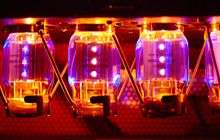
Vacuum tubes were the dominant active electronic components in bass amplifiers manufactured from the 1950s until the early 1970s, and tubes continue to be used in the 2010s for expensive bass combo amplifiers, amp heads, and preamplifiers (as well, tube amps continue to be used by audiophiles for some expensive home hifi stereo systems). Tube amplifiers for bass almost always use class AB1 topology for efficiency reasons.
Many bass players believe that tube amplifiers produce a "warmer" or more "natural" sound than solid state amplifiers when lightly or moderately driven, and more pleasing distortion characteristics when overdriven. Some performers also believe that tube amps have a greater level of perceived loudness for a given amount of amplifier power. Even though tube amplifiers produce more heat than solid state amplifiers, few manufacturers of tube amplifiers include cooling fans in the amplifiers' chassis. Usually adequate cooling is provided by passive convection. Adequate airflow is needed to prevent excessive heat from shortening the tubes' lifespan or producing tonal inconsistencies.[13] Tube amplifiers require more maintenance than solid state transistor amplifiers, such as replacing vacuum tubes or rectifying the tubes.
Tube amplifiers are usually heavier than an equivalently powered transistor amplifier. As tubes are made of glass, tube amplifiers are more fragile than a solid state amp.
Solid state amplification
By the 1960s and 1970s, semiconductor transistor-based amplifiers (also called "solid state") began to become popular. This was in large part because for a given wattage level and feature level, solid state amplifiers are less expensive, lighter weight, and require less maintenance than tube amplifiers. As well, transistor amplifiers are more reliable and less fragile than tube amps. In some cases, tube and solid state technologies are used together, usually with a tube preamplifier driving a solid state power amplifier. There are also an increasing range of products that use digital signal processing (DSP) and digital modeling technology to simulate many different combinations of amp and cabinets.
The output transistors of solid state amplifiers can be passively cooled by using metal fins called heat sinks to radiate away the heat. For high-wattage amplifiers, a fan is often used to move air across internal heatsinks.[14] Since transistor bass amplifiers used for large venues need to produce a high output, this usually means that bass amplifiers are very heavy. Most powerful transistorized bass amplifiers use class AB or so-called "push-pull" topology, in no small part because this output circuit scheme can be physically lighter and cooler than an equivalent Class A amplifier. These need heavy transformers and require large metal heat sinks for cooling.
However, Class D amplifiers (also called "switching amplifiers" or confusingly, "digital amplifiers") are more efficient than conventional Class-AB amplifiers, and so are lighter in weight and smaller. The Acoustic Image Focus head, for example, produces 800 watts of power and weighs 2.2 kilograms (about 4 pounds). Class-D amplifiers use MOSFETs (Metal Oxide Semiconductor Field Effect Transistors) rather than 'ordinary' (bipolar) transistors, and generate a pulse-width modulated signal that is filtered before it reaches the speaker.[15] In the 2010s, the availability of Class D amplifiers has enabled amp manufacturers to produce very lightweight and small, yet very powerful amp heads and small, lightweight combo amps.
Hybrid
Hybrid bass amplifier heads typically pair a tube preamplifier with a solid-state power amplifier. This provides the player with the best elements of both amplifier technology. The tube preamp gives the player the ability to obtain tube amplifier tone, which tube enthusiasts state is "warmer" than a solid state (transistor) preamp. As well, tube users state that tube preamps have a more pleasing-sounding, natural tone when the preamp's volume is pushed up so high that the bass signal becomes overdriven; in contrast, a solid state preamp that is pushed to the point of signal "clipping" can be harsh-sounding. Some hybrid amp heads have a bypass switch, so that the tube preamp can be bypassed, if the tube breaks or develops a technical problem. The tube preamplified signal in a hybrid amplifier head is then sent to a solid state power amplifier. Compared with tube power amps, solid state power amplifiers are more reliable, require less maintenance, less fragile and lighter in weight. A hybrid tube preamp/solid state power amp thus provides a bass player with the benefits of both technologies' strengths: tube preamp tone and solid state reliability for the power amp.
Power in watts and volume
.jpg)
The relationship between perceived volume (loudness) and power output in watts of an amplifier is not immediately obvious. While beginners sometimes assume that there is a linear relationship between perceived volume and wattage (e.g., beginners may think that a 50-watt amp will be much louder, or about ten times louder than a 5-watt amp), in fact the human ear perceives a 50-watt amplifier as only twice as loud as a 5-watt amplifier (which is a tenfold increase in power in watts). Doubling the power of an amplifier results in a "just noticeable" increase in volume, so a 100-watt amplifier is only just noticeably louder than a 50-watt amplifier. Such generalizations are also subject to the human ear's tendency to behave as a natural audio compressor at high volumes.
Because bass amps have to reproduce lower frequencies than an electric guitar amp, and it takes more amplifier power to reproduce bass frequencies, a bass player will typically need three or four times the wattage of the electric guitarist.[16] For example, if an electric guitarist has a 100 watt amp, the bassist in the band should have a 300 to 400 watt bass amp. For electric guitar amps with 50 watts or less of power, a bass player may need an even higher multiple. While an electric guitarist will often find that a 50 watt amp will be adequate for rehearsals and mid-size performance venues, a bass player performing alongside this electric guitarist will typically need at least a 300 watt bass amp, six times the power of the electric guitar amp, to get a good bass volume. "More advanced players who regularly gig in small to medium sized venues...typically [use amps that] produce 300-700 watts of output."[17] Bass players using bass stacks in very large venues (e.g., stadiums, outdoor festivals) may use amp heads that put out 750 to 2000 watts of power. British rock bassist Mo Foster tours with a 1,500 watt bass rig.[18] Somewhat controversially, as there is no clear engineering support, many think that a tube bass amp will sound louder than a solid state bass amp of the same wattage.[19]
Most bass amps have only one rated wattage. A small number of amps, such as the Mesa/Boogie Strategy 88 amp head, have switchable wattage. A selector switch on the 88 enables the bassist to choose its full 465 watt power; half power (250 watts); or low power (125 watts). A bassist playing an arena on one night, then a club gig, and then recording in a studio could use full, half and low power for the different volume requirements. The Quilter 800 Bass Block has a "master control" knob which switches between various watt outputs for a similar approach.
.jpg)
The way that manufacturers state the wattage output of an amplifier can be confusing. Amplifier manufacturers may state that a combo bass amp produces 600 watts at 4 ohms and 300 watts at 8 ohms. If the speaker mounted in the combo amp is an 8 ohm speaker, then the combo by itself will only produce 300 watts. This combo amplifier will only put out 600 watts if an "extension speaker cabinet" is plugged into the combo amp with a speaker cable. Plugging a second 8 ohm cabinet in parallel wiring with the combo amp's internal 8 ohm speaker will lower the amp's impedance (electrical resistance or "load") to 4 ohms; at this point the amp will put out 600 watts. Another factor that can make it difficult for bassists to select a bass amp is that different manufacturers may state their amps wattage in Root Mean Squared (or "RMS") and in "peak power". For example, a bass amp ad may state that it produces 500 watts RMS and 1000 watts "peak power". The RMS figure is much more important than the peak power wattage.

The way that cabinet manufacturers state the power handling capabilities of a speaker cabinet (or an individual speaker) can also be confusing. An important figure for a speaker cabinet's power handling capabilities is its rated wattage-handling capabilities as "RMS". For example, a bass speaker cabinet's back panel may state that it has a power handling capacity of 500 watts RMS. This means that the speaker can handle an average power, from a power amplifier, of 500 watts. The speaker can also handle occasional peaks or "transient" bursts of higher wattages, so long as these are brief. Where is becomes confusing is that some manufacturers also list "peak power", also called "maximum power", "max power" or "burst power". Peak power is the power-handling ability of the speaker for very short bursts of high-wattage signal. The RMS figure is much more important than the "peak power" or "max power" figure. To add to the confusion, some manufacturers state the "program power" capabilities of their speaker cabinet, which can be a vague and less defined term. Reputable, major manufacturers state the RMS output and/or power-handling capabilities of their gear.
Another factor that may need to be considered is the length of the speaker cable. Very long speaker cable runs may affect the performance of the system, either by causing line loss of power or by affecting the impedance. For best performance and highest wattage output with bass stacks or combos with extension speakers, bassists typically use the shortest possible speaker cable.
One of the factors bassists keep in mind when selecting a combo amp or an amp head is the amount of "headroom" that the amplifier will provide them, given their intended performance venue and music genre. "Headroom" refers to the amount by which the signal-handling capabilities of an audio system exceed a designated nominal level.[20] Headroom can be thought of as a safety zone allowing transient audio peaks to exceed the nominal level without damaging the system or the audio signal, e.g., via clipping. In loud music genres and in genres where bassists seek a clean, clear bass tone, bassists seek to avoid power amplifier clipping, so they typically choose amplifiers which provide enough headroom to avoid power amp clipping. Headroom has been defined as a "...safety zone or wiggle room".[21]"[H]aving enough headroom is essential for solid-state equipment like bass amplifiers and power amplifiers. If you lack this, you can expect a harsh mid range tone, a lack of dynamics and possibly blown speakers".[21] Having enough headroom is also important for bassists seeking to retain a "clean" sound even in loud, high-volume performance settings.
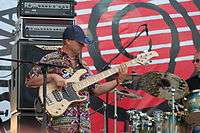
Bassists pairing an amplifier "head" of a certain wattage and a speaker cabinet (or speaker cabinets) with a certain wattage power-handling capacity may require advice from music store amplifier expert or an audio engineer. One of the reasons that many beginning bassists choose combo amps when they are starting is because with a combo amp, the manufacturer has ensured that the speaker and power amp are compatible from a power handling and impedance perspective. While there is a widespread belief that an amplifier with a rated wattage that is higher than the rated wattage on a speaker cabinet will harm the speaker, in fact, a clean, un-clipped power amplifier signal can be above the rated wattage of a speaker without damaging the speaker, as long as the power amp is sending out a clean, unclipped signal. There is a much higher risk of damaging a speaker when a clipped (unintentionally distorted) power amplifier signal is sent through it, even if the wattage is far below the rated wattage of a speaker. For example, a bassist could use a 700 watt power amp which is running with zero power amp clipping through a speaker cabinet rated at 500 watts without damaging the speaker; however, if a 100 watt power amp that is heavily clipping is plugged into the speaker cab, this could blow the speaker.
Power amp clipping is not the same thing as preamp/preamp tube clipping. Sending a power amp signal that is getting power amp clipping to a speaker can blow the speaker. Sending a preamp/preamp tube clipped signal through a speaker is not harmful. In practice, part of the "breaking up" amp sound, of a "cranked" amplifier, which is widely appreciated by hard rock, metal, punk and blues musicians, is a mix of preamp and power amp clipping. One of the benefits of using a separate components head system, in which a separate preamp and power amp are mounted in a rack, is that the bassist or bass tech can watch for the clipping warning LED on the power amp and lower the power amp volume, if necessary.
Impedance
The power handling capabilities of a speaker cabinet or individual speaker are always given in relation to a specific impedance (a measure of electrical resistance); the most common impedance ratings in bass speaker systems are 8 ohms and 4 ohms, although some equipment is rated down to 2 ohms or even more rarely to 1 ohm. For example, the Aguilar DB751 puts out 975 watts if plugged into a 2 ohms speaker cab, 750 watts at 4 ohms, or 400 watts at 8 ohms. The way to interpret ohms ratings is "backwards" to the way wattage ratings are assessed. That is, with wattage, bassists make sure that their amplifier does not put out too high a number of watts for a speaker cabinet, but with impedance, bassists ensure that the amplifier does not put out too low an impedance for a speaker system. For example, if an amplifier head is rated at 4 ohms, a 4 ohm speaker, an 8 ohm speaker (or any ohm rating higher than 4 ohms, including 16 ohms or 32 ohms) could be connected (albeit with the amplifier producing less watts as the number of ohms, the resistance, increases). However, bassists do not connect a 2 ohm speaker cabinet to a 4 ohm amplifier, because this will be too much of a load (too low an impedance) on the amplifier, and it could damage or destroy the power amplifier.
Bassists can put an incorrect (that is too low) impedance load on their amplifiers even if they connect multiple speakers that are at the correct impedance rating. For example, if a bassist has a combo amp in which the power amp is rated at 4 ohms, and she/he plugs in a second 4 ohm speaker cabinet in parallel, this will drop the impedance ("load") on the amplifier down to 2 ohms, which is too low for the amplifier. When speakers of different impedance are wired up together (e.g., an 8 ohm speaker cabinet and a 4 ohm speaker cab, the impedance is calculated differently). In most applications, when bass speakers are plugged into an amplifier, they are wired in parallel. The parallel "input/output" speaker jacks on the rear of most bass cabinets, when plugged into additional speakers in a "daisy chain" approach, will cause the speakers to be connected in parallel. More rarely, bass speaker cabs may be wired up in series, which means that the impedance is calculated differently. Series wiring is much more complicated and in cases where a bassist is using series wiring, a custom-made cabling system is typically used. Some bass manufacturers that build large speaker cabinets with multiple speakers may wire some of the speakers in series and some in parallel to achieve a certain impedance rating for the entire speaker cabinet (e.g., in 8x10" speaker cabinets, the speakers inside the cabinet may be all wired up in series, but the overall cabinet's "input/output" jacks are in parallel). Professional bass technicians and speaker designers setting up custom-made bass speaker systems for bass players from major bands may use an electronic meter to test the impedance of the speaker cabinets they design.
Power supply
The vast majority of bass amps in the 2010s can be powered solely by AC mains power, obtained by plugging the amp into a wall socket. Inexpensive practice amps may have the AC mains plug hardwired into the unit. Middle-priced to high-priced amplifiers typically have a removable cable and plug, as used with PC computer towers. The benefits of having a removable cable and plug is that if the cable becomes worn or damaged, a new cable can easily be replaced by a layperson. If a hardwired AC mains cable and plug becomes worn or damaged, a qualified technician or electrician will typically be required to replace the cable and plug. Most amps are designed to work for a single voltage. A small number of expensive bass amps designed for touring professionals have user-selectable voltage, which enables a bassist to play with same amp in North America and Europe. A small number of small combo amps can run on both AC mains power and battery power. This enables bassists to play outside where there is no access to power (e.g., for busking on the street). Amps that are battery powered may have a 12 volt input, enabling the unit to be connected to a car battery with alligator clips.
Loudspeakers
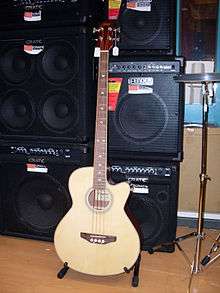
The lowest note on the double bass or four-stringed electric bass is E1, two octaves below middle C (approximately 41 Hz), and on a five-string it is B0 (approximately 31 Hz).[22] The requirement to reproduce low frequencies at high sound pressure levels means that most loudspeakers used for bass guitar amplification are designed around large diameter, heavy-duty drivers, with 10", 12" and 15" being most common. Less commonly, larger speakers (e.g., 18") or smaller speakers (e.g., the 8x8" cabinet, which contains eight 8" speakers) may be used. As a general rule, when smaller speakers are used, two or more of them are installed in a cabinet (e.g., 2x10", 4x10" and 8x8"). For 12" speakers, combo amps and cabinets are available with 1x12" and 2x12"; less commonly, 4x12" cabinets are seen. For 15" speakers, combo amps and cabinets usually have 1x15", although 2x15" and even 4x15" cabinets exist (Lemmy Kilmeister of Motorhead used 4x15" cabinets). A small number of 1x18" bass cabinets are sold (e.g., Trace Elliot).
For 10" speakers, the most common combo amp and speaker cabinet configurations are 2x10" and 4x10". For speaker cabinets, 2x10" and 4x10" are the most widely used, although 8x10" cabinets are used in stadium concerts, especially in louder rock genres. Other configurations with 10" speakers do exist, but they are less common. For example, there are a small number of 1x10" and 3x10" combo amps and speaker cabinets, and a small number of 6x10" cabinets. Bass speakers are usually made with stiff paper cones. Hartke combo amps and speaker cabinets are unique in that the cone is made from paper, except for the middle, which is made of aluminium. Gallien-Krueger's MB210-II combo amp uses ceramic speakers.
On the smaller end of the speaker spectrum, some small practice combo amps have 1x3", 2x5", 1x6.5", and 1x8" speakers.
Many manufacturers abbreviate the number and size of speakers in the name of their equipment. For example, a Fender bass combo amp with two 10" speakers may be called the "Fender 210". Similarly, a Fender cabinet with two 12" speakers may be called the "Fender 212". Another abbreviation that is used is to add the wattage to the name. Thus a 500 watt Yamaha combo amp with two 12" speakers may be called the "Yamaha 212-500".
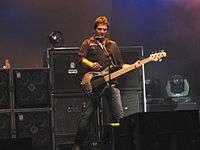
Bassists who want a more powerful low end may use a subwoofer cabinet. Subwoofers are specialized for very low frequency reproduction, with typical maximum useful high frequencies of about 150 or 200 Hz, so a subwoofer cabinet must be paired with a full range speaker cabinet to obtain the full tonal range of an electric bass or upright bass. In addition, subwoofers intended for PA system use have much higher power handling requirements than do subwoofer designs for high fidelity home use. Bass guitar players who use subwoofer cabinets include performers who play with extended range basses with include notes between B0 (about 31 Hz); and C#0 (17 Hz) and bassists whose style requires a very powerful sub-bass response is an important part of the sound (e.g., funk, Latin, gospel, R & B, etc.).
Keyboard players who use subwoofers for on-stage monitoring include electric organ players who use bass pedal keyboards (which go down to a low "C" which is about 33 Hz) and synth bass players who play rumbling sub-bass parts that go as low as 18 Hz. Of all of the keyboard instruments that are amplified onstage, synthesizers produce some of the lowest pitches because, unlike a traditional electric piano or electric organ which have as their lowest notes a low "A" and a low "C", respectively, a synth does not have a fixed lowest octave. A synth player can add lower octaves to a patch by pressing an "octave down" button, which can produce pitches that are at the limits of human hearing.
Several concert sound subwoofer manufacturers suggest that their subs can be used for bass instrument amplification. Meyer Sound suggests that its 650-R2 Concert Series Subwoofer, a 14-square-foot (1.3 m2) enclosure with two 18-inch drivers, can be used for bass instrument amplification.[23] While performers who use concert sound subwoofers for onstage monitoring may like the powerful sub-bass sound that they get onstage, sound engineers may find the use of large subwoofers (e.g., two 18" drivers) for onstage instrument monitoring to be problematic, because it may interfere with the "Front of House" sub-bass sound.
Cabinet design
Most bass speaker cabinets employ a vented bass-reflex design, which uses a port or vent cut into the cabinet and a length of carefully measured tubing or pipe to increase the low-frequency response and improve the speaker system's efficiency. To give an example, if one compares two bass cabinets, each with the same type and power of power amplifier, one cabinet being a sealed box and the other being a vented or ported cabinet, most listeners will perceive that the ported cabinet produces more bass tone and deeper bass tone. Less commonly, some bass speaker cabinets use one or more passive radiator speakers, a voice coil-less "drone cone" which is used in addition to a regular woofer to improve the low frequency response of a cabinet. Passive radiator speakers help to reduce the risk of overextension. Acoustic suspension designs with sealed cabinets are relatively uncommon because they are less efficient. Some cabinets use a transmission-line design similar to bass-reflex, and in rare cases, some large cabinets use horn-loading of the woofers (e.g., the Acoustic 361 18" speaker cabinet from the late 1960s).
It is typically not possible to combine high efficiency (especially at low frequencies) with compact enclosure size and adequate low frequency response. Bass cabinet designers can, for the most part, choose only two of the three parameters when designing a speaker system. So, for example, if extended low-frequency performance and small cabinet size are important, one must accept low efficiency.[24] This rule of thumb is sometimes called Hofmann's Iron Law (after J.A. Hofmann, the "H" in KLH).[25][26] Bass cabinet designers must work within these trade-offs. In general, to get extended low-frequency performance, a larger cabinet size is needed. Most bass cabinets are made from wood such as plywood. Gallien-Kruger makes a small extension cab made of aluminum.
Most bass combo amps and bass speaker cabinets are "front-firing"; that is, the speakers and horn, if a horn is present, aim forwards. However, because very low-pitched sounds are omnidirectional, some combos and cabinets have woofers that point down or to the rear. The deep bass tone radiates from the cabinet in all directions, even when it is pointed downward or to the rear. The Acoustic Image combo bass amp has a downward-firing woofer for the deepest pitches, and another forwards-firing speaker for higher-pitched sounds. The vintage Acoustic brand 361 cabinet had a rear-firing 18" woofer, an approach used in a number of home cinema subwoofer cabinets. The rare examples of bass cabinets that use a large folding horn can also use woofers that do not face forward.
Bass combo cabinets and speaker cabinets are typically cube- or rectangle shaped. However, some small- to mid-sized combo amp cabinets have a wedge shape, like a keyboard amp or a stage monitor speaker cabinet. The wedge shape, also called a "rock back" feature, enables a bassist to point their speakers up towards themselves, to make it easier to hear their sound.
Tweeters
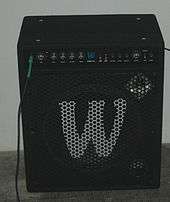
High frequency tweeters, typically horn-loaded, are included in some bass instrument speaker cabinets. Vox's 1960s-era "Super Beatle" amplifier was an early enclosure that used horn tweeters. During the late 1960s Acoustic's 260 Series guitar amp used a treble horn in the dual 15" loudspeaker 261 guitar enclosure, and Kustom's nearly 5-foot-tall (1.5 m) 2J + 1H guitar enclosure used two 15" speakers and a 15" diameter treble horn. Horn-equipped cabinets were not available for bass players until much later.
In the early 1980s, some performers began using two-way or three-way cabinets that used 15" woofers, a vented midrange driver and a horn/driver, with an audio crossover directing the signal to the appropriate driver. Folded horn bass guitar rigs have remained rare due to their size and weight. As well, since the 1990s, most clubs have PA systems with subwoofers that can handle the low range of the bass guitar. Extended range designs with tweeters were more the exception than the rule until the 1990s. The more common use of tweeters in traditional bass guitar amplifiers in the 1990s helped bassists to use effects and perform more soloistic playing styles, which emphasize the higher range of the instrument.
One problem with adding a tweeter to a bass speaker cabinet is that the tweeter may be damaged by the overdriven amplifier tone that is popular in some musical genres, since overdriving the amplifier adds a great deal of high frequency information to the signal. Horns and speakers in the same cabinet are sometimes wired separately, so that they can be driven by separate amplifiers. Biamplified systems and separately-wired cabinets produced by manufacturers such as Gallien-Krueger and Carvin and other manufacturers allow bassists to send an overdriven low-pitched sound to the speaker, and a crisp, undistorted high-pitched sound to the horn, which prevents this problem. Since the 1960s, some bassists have obtained a similar result by plugging their bass into both an electric guitar guitar amp and a bass amp. This approach does not use a crossover, but since an electric guitar amp will only produce pitches down to about 80 Hz, the guitar amp reproduces the mid- to high frequencies and the bass amp reproduces the low frequencies. With this arrangement, distortion and other effects can be applied to the guitar amp without affecting the solidity of the bass amp tone.
Some bass amplifier combos have a "whizzer cone" attached to the low frequency woofer's centre. The whizzer cone is about the same size as a dust cap, although it resembles a miniature speaker cone. The whizzer cone handles the upper frequencies that are too high for the woofer. Roland's 60 watt and 120 watt bass combos contain both a woofer and a whizzer cone.
Controls, jacks and indicator LEDs
Controls

There are two main types of controls on bass amps: switches and rotary knobs. The simplest, least expensive practice amps and combo amps may only have a few switches and knobs, such as an "on/off" switch, a volume knob, and a bass and treble control knob. Mid-priced models may add additional tone controls (e.g., one, two or three "midrange" controls and a "presence" knob for very high frequencies) and/or add a second type of volume knob called a "gain", "preamplifier" (or "preamp"/"pre"), or "drive" (short for "overdrive") control. A good selection of equalizer knobs and gain stages is standard on expensive amplifiers. If an amp has one or more preamp or gain knobs, the second volume knob may be called "master", "volume" or "post".
Amplifiers for electric guitars are more likely than bass amps to have multiple "channels", but some bass amps also have channels. By providing two or more "channels", each with its own gain, equalization and volume knobs, a bassist can preset various settings (e.g., an accompaniment setting for playing a backing part and a solo bass setting for playing a bass solo). In a heavy metal band, a bassist may use a multi-channel amp to have one setting with an aggressive overdrive, while another channel has a "clean" sound for ballads.
.jpg)
On some amps, setting the "gain" or "drive" control above a certain setting causes an overdrive effect, either due to the natural effect of overloading the preamplifier (or the preamp tube on a tube amplifier) and/or due to a distortion effect being turned on. Tube amplifiers typically also have a "standby" switch in addition to an "on/off" switch. Controls are typically mounted on the front of the amplifier near the top of the cabinet; often the knobs are recessed so that they do not project beyond the wooden cabinet, to protect the knobs during transportation. On amplifier "heads", protective metal U-shaped protrusions may be used to protect the knobs during transportation. On some amps, notably Roland models, the knobs and switches may be on top of the amplifier, at the rear of the top surface. Again, the knobs are usually recessed below the top of the wooden cabinet to protect them.
Mid-to high-priced amps may have other switches (which on some amps are switched on by pulling an existing rotary knob out) that boost or cut some part of the frequency range, such as "bright boost", "deep boost" or "mid scoop" switches. Amps with an onboard audio compressor or limiter, which is used to protect the speakers from sudden peaks in volume and from damage due to power amplifier clipping, may have only an on/off switch to turn on the effect (as with lower- to mid-priced amps), or they may have one or more knobs to control how much compression is applied to the bass tone (typically a ratio and threshold knob or just a single knob). Some 2000s-era amps may have an electronic tuner and a mute button, to mute the sound of tuning during a break between songs without having to change the volume settings. On some amps, vertical sliders may be provided to control a graphic equalizer, which gives the bassist control over a number of frequency bands.
Higher-cost amps for professionals with an XLR DI out jack may also have a "ground lift" switch (to be used in case of a humming ground loop), a DI out level control knob, and a switch which determines whether the DI out signal to the PA or recording mixing board is pre- or post- the amp's internal preamplifier and equalization circuitry. The pre-/post- switch enables a bassist to decide whether to send the audio engineer just the signal from her bass, or to send the signal once it has been pre-amped and equalized by her amp settings. Some higher-cost amps may have a parametric equalizer (or a semi-parametric equalizer) for some frequency ranges (typically the middle frequency range), which can be used to modify the bass tone to suit different styles or performance venues. Some bass amps have a 15 or 20 dB pad which can be used to attenuate "hot" signals, such as basses with an internal preamplifier (depending on the model of amplifier, some brands may provide two inputs (high and low gain) instead of providing a "pad". This pad can be turned on using a button. Some bass amps have an even stronger pad, a 40 dB pad.
Some bass amps may have additional controls for onboard effects such as bass chorus or a knob for controlling a multi-effects unit (which might include a suboctave generator, chorus, reverb, fuzz bass etc.). Some 2000s-era amps may have a knob to control digital amp or speaker emulation settings (e.g., emulating the tone of a huge 8x10" speaker stack or a vintage tube amp by famous makers, such as the Ampeg SVT).
Input and output jacks
.jpg)
Bass amps come with a range of different input and output jacks, depending on the cost of the amplifier and its intended purpose. The least expensive practice amps may only have a single 1/4" input jack and no output jacks. Some practice amps and small combo amps have RCA or 1/8" inputs for plugging an MP3 player or CD player into the bass amp, to facilitate practicing with a recording. Some amps have a high-gain input, for basses which have internal preamplifiers one the instrument. The high-gain input is routed through a pad (attenuator). An amp may also have a low-gain input, which is unattenuated, for regular basses. Some combo amps have a 1/4" auxiliary input, which could be used to plug in a keyboard, drum machine or second bass.
Lower-priced amps may have a preamp out. While this signal can be plugged into a mixing board, it is preferable to use a DI output for this purpose because a preamp out is a 1/4" unbalanced signal. Unbalanced signals are more prone to unwanted hum and noise. Bass amps intended for use by professional players may have an XLR DI output so that the amp can be connected directly to a mixing board of a PA system or recording set-up. Some bass amps have a 1/4" headphone out jack, so that the bass amp can be used for silent practice. When the headphone is plugged in, the amplifier to the speaker is normally automatically turned off. Higher-priced amps designed for professionals often have "preamp out" and "power amp in" jacks, which can be used to make an effects loop. The power amp in jack can also be used to plug in an external preamplifier pedal, which would then bypass the amp's onboard preamp and EQ section.
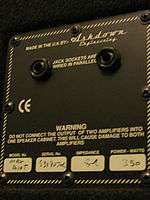
Some bass amps have two inputs. One some amps, one is a high gain input and the other is a low gain input. On other amps, the two inputs may be intended so that two basses can be plugged in at the same time. On these amps, there may be a separate volume control for each input; this is done to enable a bass player to switch between two instruments on different songs (e.g., a fretted and fretless bass) without having to unplug and plug in jacks. For example, the vintage Traynor Bass Master tube head has two inputs, each with its own volume control. Some bass amps have an auxiliary in jack, for plugging in a drum machine, keyboard bass or synthesizer. Some bass amps also have an external speaker out jack. While this jack is also 1/4", a speaker cable must be used with this jack, rather than a patch cord, because it sends a powered signal out to an external speaker cabinet. Higher-powered and more expensive amps may have Speakon output jacks.
On some amps with a number of input and output jacks, the jacks may be consolidated in a patch bay. Some amps have an input jack for a foot-operated switch which can be used to turn on an effect or switch to a solo channel. Some higher-end amps have a Speakon speaker jack for an extension speaker. In the 2010s, the Speakon jack is often used in high wattage amplifiers, because the design of the connector, which is shielded from human touch, prevents electrical shock from a high-powered amplifier. Some amplifiers have a "tuner out" jack, for sending the instrument signal to an external electronic tuner. Bass speaker cabinets often have two 1/4" jacks. These are provided so that one speaker cable can be plugged into the first jack and connected to the power amp; if the bassist wants to use a second cabinet, a second speaker cable is plugged into the second jack and then into second speaker.
A small number of bass amps designed for the upright bass have both a 1/4" input for a piezoelectric pickup and an XLR input for a condenser microphone mounted on the bass, with a simple mixer for combining the two signals, as described below. Some Acoustic Image amps have a dual input design. A rare feature on expensive amplifiers (e.g., the EBS TD660) is the provision of phantom power to supply electrical power over the patch cable to bass pickups, effects, a condenser mic (for an upright bass player) or other uses. A small number of 2010-era amps that have digital modelling features may have an input for a computer (e.g., USB), so that new digital effects and presets can be loaded onto the amp.
The most common way that bass players connect their instrument to their bass amp is by using a 1/4" patch cord, a standard signal cable used in music and audio applications. Some bassists plug their bass into a small wireless transmitter about the size of a pack of cards, which can be clipped to the strap or to their belt. The transmitter transmits the bass signal to a receiver that is plugged into the amp. Bassists playing in large venues with complex stage set-ups, or a stage design where there is a large distance between performers, or players who like to dance or go out into the audience during the performance, may use wireless transmitters to avoid the risk of having their cable become disconnected while they move about on stage and give themselves more freedom. Another reason that some bassists use wireless transmitters is if their stage setup requires a long cable run between their bass and their amp. Long cable runs can weaken the strength of the signal and can adversely affect tone and sound quality.
Indicator LEDs
The least expensive practice amps and basic combo amps may only have a single indicator light: an LED to indicate when the amp's power is on. More expensive amps may also have LEDs to indicate when the preamp has a signal present from the instrument (helpful for troubleshooting during set-up, because if the amp is not producing any bass sound even when the bassist is playing, and the "signal present" light is illuminated, this indicates that a signal is reaching the amp); when a limiter or similar speaker protection feature is activated (e.g., Peavey's DDT system); when clipping is occurring; or when the amp is in standby mode. Amps with a built-in tuner typically have several LEDs to indicate when the note being played is flat, sharp, or in tune.
Amplifying the double bass
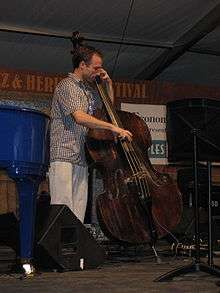
Almost all bass amplifiers are designed for use with an electric bass, which has magnetic pickups. When a double bass player is plugging their instrument into a typical bass amp, the signal usually comes from a piezoelectric pickup mounted on the bridge or beneath the feet of the bridge. The direct signal from a piezoelectric pickup does not usually sound good when it is plugged into a standard electric bass amp. Many upright bass players who use piezoelectric pickups use a preamplifier or preamp-equipped DI box before the signal is sent to the bass amp. The preamplifier helps to ensure that the impedance of the pickup signal matches the impedance of the amplifier, which improves the tone. Some preamplifiers also have equalizers which can be used to modify the tone.
Double bass players performing in genres where the bass is slapped, either by pulling the string until it snaps back onto the fingerboard or striking the strings, such as traditional blues, rockabilly, psychobilly jazz, folk, and bluegrass often blend the sounds picked up by a piezoelectric transducer with the sounds picked up by a small condenser microphone mounted on the bridge. The microphone picks up the resonance coming from the body and the sounds of the strings being plucked, bowed, or slapped. The two sound signals are blended using a simple mixer and then routed to the amplifier. While many upright bass players use combo amplifiers, bassists in genres that use high stage volume, such as the punk-rockabilly genre of psychobilly use "bass stacks". Some jazz bassists and other bass players who play in small venues use specialized, expensive upright bass amps, like the Acoustic Image combo amplifier.
Double bass players playing in genres where a louder amplified tone (emphasizing the fundamental frequencies) is desired for the bass may be more likely to face the problem of audio feedback. Feedback for double bass generally manifests itself as a sharp, sudden high-volume "howling" sound that can damage loudspeakers. When acoustic instruments with resonant bodies are amplified with microphones and piezoelectric transducer pickups, the common approach used for amplified double basses, they are prone to have feedback problems. For acoustic bass guitars, soft plastic discs are available to block the sound hole, thus reducing feedback. Upright bass players sometimes use homemade foam or styrofoam inserts to fill in the "f" holes of the double bass, which can reduce feedback.
Other ways to reduce feedback include: playing with the bass amp's speaker cabinets in front of, rather than behind, the instrument; reducing the onstage volume; moving the bass away from other loud instruments, such as the drum kit (low toms can trigger feedback on some basses) or the rhythm guitar player's amp); signal phase reversing; using a parametric equalizer or "notch filter" EQ to turn down the frequency that is feeding back; or using "feedback eliminators", which are basically automatic notch filters that find and turn down the frequency that is "howling". Some other ways to reduce feedback are to use a plywood laminate bass rather than a carved wood bass, use a solid - body electric upright bass and/or use magnetic or optical pickups. Many of the methods used to reduce feedback (notch filters, filling the f-holes with foam) have effects on the tone of the instrument. However, these drawbacks need to be considered against the significant problems for the audience's experience caused by unwanted feedback.
Preamplification and effects
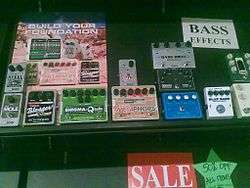
The basic sound of the amplified electric bass or double bass can be modified by electronic bass effects. Since the bass typically plays an accompaniment, beat keeping role as a rhythm section instrument in many styles of music, preamplifiers ("preamps"), compression, limiters, and equalization (modifying the bass and treble frequencies) are the most widely used effect units for bass. The types of pedals commonly used for electric guitar (distortion, phaser, flanger, etc.) are less commonly used for bass, at least in bands or styles where the bassist mainly plays a rhythm section role. In styles of music where the bass is also used as a soloing instrument (certain genres of heavy metal, progressive rock and jazz fusion), bassists may use a wider range of effects units. Jazz fusion bassists who play fretless bass may use chorus effect and reverb for their solos.
A range of other effects are used in various genres. "Wah-wah" and "synth" bass effects are associated with funk music. As well, since the 1960s and 1970s, bands have experimented with "fuzz bass" where the bass is distorted either by overdriving the amp or by using a distortion unit. Fuzz bass was used by psychedelic rock bands in the 1960s and early 1970s and in traditional heavy metal bands (Led Zeppelin) during the same era. Octave-generating effects, which generate an octave below the pitch being played are also used by bass players. Many bassists in modern-day hard rock and heavy metal bands use overdrive pedals specifically made for bass guitar. Since the late 1980s, bass-specific overdrive pedals have been available; these pedals maintain the low fundamental pitch. Using a regular guitar distortion pedal for bass would result in the lower frequencies being greatly lessened. Well-known overdrive effects for bass include the BOSS ODB-3 Bass Overdrive, Electro-Harmonix Bass Blogger, Tech21 Sansamp Bass Driver, the DigiTech|DigiTech XBD Bass Driver , and the Electro-Harmonix Big Muff.
Overdrive built into amplifiers
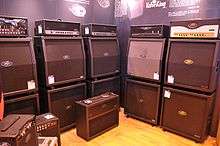
Some bass amplifiers have an "overdrive" or distortion effect built into the unit. The Peavey Century 200 has an onboard "distortion" effect on the second channel. The Peavey VB-2 also has built-in overdrive. Aguilar Amplification's AG 500 bass head is a two-channel amplifier, one of which offers a "saturation" control for overdrive. A variety of BOSS combo amplifiers have a built-in "drive" effect. Gallien-Krueger's bass amp heads have a "boost" control which provides a simulated tube overdrive effect. The Behringer Ultrabass BVT5500H Bass Amplifier Head has a built-in limiter and overdrive. The LowDown LD 150 bass amp has a range of overdrive sounds, from a slight hint to heavy distortion. The CUBE-20XL BASS amp includes built-in overdrive.
The 75 Watt Fender Rumble 75 Bass Combo Amp and its 150 Watt and 300 Watt counterparts can produce an overdrive effect by using the gain and blend controls, giving overdrive sounds ranging from "mellow warmth [to] heavy distorted tones".[27] The Fender SuperBassman is a 300-watt tube head which has a built-in overdrive channel. The Fender Bronco 40 includes a range of effects including modern bass overdrive, vintage overdrive and fuzz.
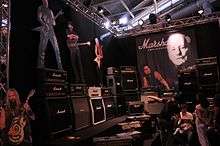
The MESA Bigblock 750 has a built-in overdrive channel. The Mesa M2000 has a high gain switch which can be engaged with a footswitch. The Marshall MB450 head and combo bass amplifiers have a tube pre-amp on the "Classic" channel which can be overdriven. The Ashdown ABM 500 EVO III 575W Bass amp head has a built-in overdrive effect. Overdrive is also available on many Crate bass amplifiers. The Yamaha BBT500H has three types of built-in drive effects: overdrive, distortion and fuzz. The Ampeg B5R Bass Amplifier has two channels: clean and overdrive, with the ability to combine the two. Verellen, a boutique amp company, produces a bass amplifier with a built in overdrive channel.
Manufacturers
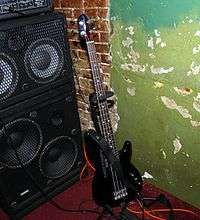
Bass amplifier equipment manufacturers include a variety of different types of companies, ranging from companies that only make individual components (e.g., Accugroove loudpeakers, a speaker manufacturer) to companies that only make bass amplifiers and loudspeakers (e.g., Gallien-Krueger). At the other end of the spectrum are companies that offer bass amplification equipment as part of a much broader offering of different types of instrument amplifiers and public address systems (e.g., Peavey, Carvin A&I or Yorkville Sound.)
Another way of categorizing bass equipment manufacturers is by which part of the market they are targeting. While Peavey and Yorkville products are aimed at the generalist mass market, some bass equipment manufacturers, such as Acoustic Image or Walter Woods make expensive "boutique" equipment that is aimed at a niche market within the professional musician market. Acoustic Image amplifiers and speaker cabinets tend to be used by professional acoustic folk and jazz musicians, and Walter Woods amplifiers are associated with professional acoustic jazz bass players.
Some of the best-known and most notable companies include:
Transportation
Some large combo amps and large speaker cabinets have ball-bearing-mounted caster wheels to make it easier to move them. All combo amplifiers and speaker cabinets have some types of carry handles, either a folding handle on the top or recessed handles on the sides. There are two types of recessed handles: some equipment has folding, spring-loaded metal handles, with the spring holding the handle flush against the chassis until it is pulled out for use; the second type is handles that are non-moving, and which are flush with the surface of the amp/cab, but with a hollow area behind the handle for the hand to go. In both cases, the handle does not project out beyond the amp/cab, preventing the handle from catching on items during transportation and/or being damaged.
Very large cabinets, such as 8x10" cabinets, may have both wheels and a long "towel bar"-style handle to facilitate moving the equipment. Some 8x10" cabinets have handles on the top and bottom to facilitate two-person carrying of the cab. Some combo amplifiers have wheels and a retractable carry handle, to enable bassists to walk while pulling their bass amp; this can enable bassists to walk onstage with their bass and amp or walk to a venue with their gear.
Some combo amp and speaker cab manufacturers sell fitted amp or cab covers, to protect the equipment from dust and inclement weather. Professional touring bassists may place their amp heads, combo amps and speaker cabinets into foam-lined road cases to protect them during transportation. Rackmounted road cases typically have recessed handles on the sides for carrying the case. Touring professional bassists may have roadies who carry their amps and cabinet on and off stage.
Alternatives
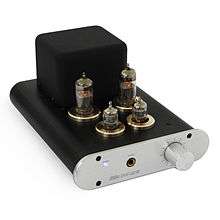
Some bass players cannot use a bass combo amp, either due to strict noise and disturbance rules in their apartment, lack of space to store a combo amp (if they live in a small room) or due to the need for a set-up which can amplify multiple types of instruments and/or voice. Alternatives to buying a bass amp for people who have noise or space constraints include a headphone amplifier or a micro-practice amp which includes a headphone jack (on bass amps, connecting headphones to a headphone jack automatically turns off the main loudspeaker). Multi-instrumentalists and bassist-singers can consider a keyboard amplifier, a small PA system, or some models of acoustic instrument amplifiers which include bass as one of the instruments which can be used; all of these options have full-range speakers that can handle the bass range.
While electric bass players have used regular guitar amplifiers in large concerts since the 1960s, this is usually just for the higher register; a bass amp is still typically used for the low register, because regular guitar amps are only designed to go down to about 80 Hz. One of the reasons bassists split their signal into a bass amp and an electric guitar amp is because this arrangement enables them to overdrive the higher-register sound from the electric guitar amp, while retaining the deep bass tone from the bass amp. Naturally-produced overdrive on bass obtained by cranking a tube amplifier or solid-state preamplifier typically results in a loss of bass tone, because when pushed into overdrive, a note goes to the upper octave second harmonic.
Bass players who do not have a combo amp who are playing live shows can connect their bass to a DI unit and from there to the PA system. In a well-equipped nightclub or music bar, the audio engineer can then route the bass signal to a stage monitor suitable for bass, so the bass player and band can hear the bass tone. Some standalone bass preamplifier pedals have a DI output, so this output can similarly be connected to a PA system. Bass players who are playing in small venues (coffeehouses, small pubs, etc.) will typically need to bring their own bass combo amp (or an alternative amp, such as a keyboard amp combo), because very small venues often have a very small, low-powered PA system which is used mainly for vocals. Some small venues do not have monitor speakers, or they have only one, in front of the lead vocalist. Bass players who do not have a combo amp who are laying down tracks in the recording studio can plug into a DI unit (any professional recording studio will have one), which is connected to the audio console; the audio engineer can provide the bassist with the sound of their instrument through headphones.
See also
| Wikimedia Commons has media related to |
Further reading
- Hopkins, Gregg; and Moore, Bill. Ampeg: The Story Behind the Sound. Hal Leonard, 1999.
- Fliegler, Ritchie and Eiche, Jon F. Amps!: The Other Half of Rock 'n' Roll. Hal Leonard Corporation, 1993.
- Zottola, Tino. Vacuum Tube Guitar and Bass Amplifier Theory. Bold Strummer, Limited, 1996.
References
- 1 2 3 Teagle, John (5 September 2002). "Antique Guitar Amps 1928-1934". vintageguitar.com. Retrieved 10 April 2018.
- ↑ Timothy Miller, "Hawaiian Guitar", The Grove Dictionary of American Music, 2nd edition
- 1 2 3 4 5 Garland, Eric (30 October 2015). "6 Classic Amps Every Bassist Should Know". reverb.com. Reverb. Retrieved 12 March 2017.
- 1 2 Simmons, Michael John (November 2013). "Catch of the Day: Circa 1969 Acoustic 360/361 Bass Amplifier". fretboardjournal.com. Fretboard Journal. Retrieved 15 May 2017.
- 1 2 3 Garland, Eric (30 October 2015). "6 Classic Bass Amps You Should Know Part II". reverb.com. Reverb. Retrieved 12 March 2017.
- 1 2 3 4 Garland, Eric (30 October 2015). "6 Classic Bass Amps You Should Know Part II". reverb.com. Reverb. Retrieved 12 March 2017.
- ↑ Jisi, Chris. "Mike Inez". bassplayer.com. Bass Player Magazine. Retrieved 1 October 2009.
- ↑ "Mesa/Boogie PowerHouse Bass Cabinet - 1x15" + 4x10" 4 Ohm". Sweetwater. Retrieved 10 April 2018.
- ↑ "Peavey PVH 1516 - 1x15" and 2x8" 900W Bass Cabinet". Sweetwater. Retrieved 10 April 2018.
- ↑ "Ashdown's B-Social Desktop Bass Amplifier". bassplayer.com. Bass Player Magazine. 10 February 2016. Retrieved 17 May 2017.
- ↑ "Ashdown's B-Social Desktop Bass Amplifier". bassplayer.com. Bass Player Magazine. 10 February 2016. Retrieved 17 May 2017.
- ↑ "Ashdown's B-Social Desktop Bass Amplifier". bassplayer.com. Bass Player Magazine. 10 February 2016. Retrieved 17 May 2017.
- ↑ McCullough, Michael "Mac" (1995), Cool it, man, archived from the original on 2006-10-19, retrieved 2010-08-23
- ↑ Power Amplifiers – General Information, [Yorkville Sound], retrieved 2010-08-23
- ↑ Mellor, David (June 2006), What is Class-D amplification? The benefits explained, Sound on Sound, retrieved 2010-08-23
- ↑ "Beginners bass amplifier guide - Which one should I buy? - Which Bass". whichbass.co.uk. 15 October 2016. Retrieved 10 April 2018.
- ↑ http://thehub.musiciansfriend.com/bass-guitar-buying-guide/bass-amplifiers-how-to-choose-the-right-bass-amp-rig
- ↑ Foster, Mo. Seventeen Watts?: The First 20 Years of British Rock Guitar, the Musicians and Their Stories. Sanctuary, 1997
- ↑ http://thevault.musicarts.com/amplifier-buyers-guide/
- ↑ "Q. What exactly is 'headroom' and why is it important?". Sound on Sound. February 2010.
- 1 2 Audio, Carvin Amps and. "Headroom: What It Is And How To Get It". carvinaudio.com. Retrieved 10 April 2018.
- ↑ Frequencies, [Contrabass Mania], retrieved 2010-08-23
- ↑ "650R2 Subwoofer". Meyer Sound Laboratories. Retrieved April 24, 2010.
- ↑ Engineer, John L. Murphy, Physicist/Audio. "TA Speaker Topics: Loudspeaker Design Tradeoffs". trueaudio.com. Retrieved 10 April 2018.
- ↑ Hofmann's Iron Law Archived 2008-03-05 at the Wayback Machine.
- ↑ "Sensitivity and Hoffman's Iron Law, or "why you can't have your cake and eat it too" – Audioblog". salksound.com. Retrieved 10 April 2018.
- ↑ http://www.musiciansfriend.com/amplifiers-effects/fender-rumble-75-75w-1x12-bass-combo-amp
